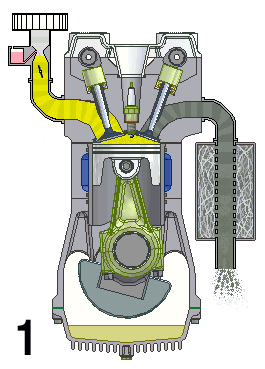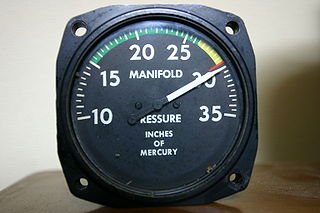

In an internal combustion engine, forced induction is where turbocharging or supercharging is used to increase the density of the intake air. Engines without forced induction are classified as naturally aspirated. [1]


In an internal combustion engine, forced induction is where turbocharging or supercharging is used to increase the density of the intake air. Engines without forced induction are classified as naturally aspirated. [1]
Forced induction is often used to increase the power output of an engine. [2] This is achieved by compressing the intake air, to increase the mass of the air-fuel mixture present within the combustion chamber. A naturally aspirated engine is limited to a maximum intake air pressure equal to its surrounding atmosphere; however a forced induction engine produces "boost", [3] whereby the air pressure is higher than the surrounding atmosphere. Since the density of air increases with pressure, this allows a greater mass of air to enter the combustion chamber.
Theoretically, the vapour power cycle analysis of the second law of thermodynamics would suggest that increasing the mean effective pressure within the combustion chamber would also increase the engine's thermal efficiency. [4] However, considerations (such as cooling the combustion chamber, preventing engine knock and limiting NOx exhaust emissions) can mean that forced induction engines are not always more fuel efficient, particularly in the case of high-performance engines.
Four-stroke diesel engines are well suited to forced induction, since the lack of fuel in the intake air means that higher compression ratios can be used without a risk of pre-ignition. Therefore, the use of turbochargers on diesel engines is relatively commonplace.
Two-stroke diesel engines have a significantly different operating principle to two-stroke petrol engines, and require some form of forced induction - generally a supercharger - in order to function.
A reduced density of intake air is caused by the loss of atmospheric density seen with elevated altitudes. Therefore, an early use of forced induction was in aircraft engines. At 18,000 feet (5,500 m), the air is at half the pressure of sea level, which means that an engine without forced induction would produce less than half the power at this altitude. [5] Forced induction is used to artificially increase the density of the intake air, in order to reduce the loss of power at higher altitudes.
Systems that use a turbocharger to maintain an engine's sea-level power output are called "turbo-normalized" systems. Generally, a turbo-normalized system attempts to maintain a manifold pressure of 29.5 inHg (100 kPa). [5]
The most commonly used forced-induction devices are turbochargers and superchargers. A turbocharger drives its compressor using a turbine powered by the flow of exhaust gases, whereas a supercharger is mechanically powered by the engine (usually using a belt from the engine's crankshaft).
Intercooling is often used to reduce the temperature of the intake air after it is compressed. Another less commonly used method is water injection (or methanol injection).

The compression ratio is the ratio between the volume of the cylinder and combustion chamber in an internal combustion engine at their maximum and minimum values.

The diesel engine, named after the German engineer Rudolf Diesel, is an internal combustion engine in which ignition of the fuel is caused by the elevated temperature of the air in the cylinder due to mechanical compression; thus, the diesel engine is called a compression-ignition engine. This contrasts with engines using spark plug-ignition of the air-fuel mixture, such as a petrol engine or a gas engine.

In an internal combustion engine, a turbocharger is a forced induction device that is powered by the flow of exhaust gases. It uses this energy to compress the intake air, forcing more air into the engine in order to produce more power for a given displacement.

In engineering, the Miller cycle is a thermodynamic cycle used in a type of internal combustion engine. The Miller cycle was patented by Ralph Miller, an American engineer, U.S. patent 2,817,322 dated Dec 24, 1957. The engine may be two- or four-stroke and may be run on diesel fuel, gases, or dual fuel. It uses a supercharger or a turbocharger to offset the performance loss of the Atkinson cycle.
A stratified charge engine describes a certain type of internal combustion engine, usually spark ignition (SI) engine that can be used in trucks, automobiles, portable and stationary equipment. The term "stratified charge" refers to the working fluids and fuel vapors entering the cylinder. Usually the fuel is injected into the cylinder or enters as a fuel rich vapor where a spark or other means are used to initiate ignition where the fuel rich zone interacts with the air to promote complete combustion. A stratified charge can allow for slightly higher compression ratios without "knock," and leaner air/fuel ratio than in conventional internal combustion engines.

A four-strokeengine is an internal combustion (IC) engine in which the piston completes four separate strokes while turning the crankshaft. A stroke refers to the full travel of the piston along the cylinder, in either direction. The four separate strokes are termed:

The Roots blower is a positive displacement lobe pump which operates by pumping a fluid with a pair of meshing lobes resembling a set of stretched gears. Fluid is trapped in pockets surrounding the lobes and carried from the intake side to the exhaust.
Volumetric efficiency (VE) in internal combustion engine engineering is defined as the ratio of the equivalent volume of the fresh air drawn into the cylinder during the intake stroke to the volume of the cylinder itself. The term is also used in other engineering contexts, such as hydraulic pumps and electronic components.

A naturally aspirated engine, also known as a normally aspirated engine, and abbreviated to N/A or NA, is an internal combustion engine in which air intake depends solely on atmospheric pressure and does not have forced induction through a turbocharger or a supercharger.
Indirect injection in an internal combustion engine is fuel injection where fuel is not directly injected into the combustion chamber.
Manifold vacuum, or engine vacuum in a petrol engine is the difference in air pressure between the engine's intake manifold and Earth's atmosphere.

The manifold absolute pressure sensor is one of the sensors used in an internal combustion engine's electronic control system.
A twincharger refers to a compound forced induction system used on some internal combustion engines. It is a combination of an exhaust-driven turbocharger and a mechanically driven supercharger, each mitigating the weaknesses of the other.
In an internal combustion engine, twin-turbo is a layout in which two turbochargers are used to compress the intake fuel/air mixture. The most common layout features two identical or mirrored turbochargers in parallel, each processing half of a V engine's produced exhaust through independent piping. The two turbochargers can either be matching or different sizes.

The MA is a straight-4 SOHC 0.9 L, 1.0 L, or 1.2 L engine first introduced in 1982 by Nissan, intended primarily for the K10 series Micra/March model. It shares design similarities with the older E engine, with an 8-valve hemispherical cylinder head but differs in that it uses an aluminium cylinder block. Unusually, the specified ignition timing for the MA10 running on the specified 90 RON gasoline was 2 degrees after top dead centre, reflecting a very high flame speed in the compact combustion chambers.

The term turbo-diesel, also written as turbodiesel and turbo diesel, refers to any diesel engine equipped with a turbocharger. As with other engine types, turbocharging a diesel engine can significantly increase its efficiency and power output, especially when used in combination with an intercooler.

In an internal combustion engine, a supercharger compresses the intake gas, forcing more air into the engine in order to produce more power for a given displacement.

A two-stroke diesel engine is a diesel engine that uses compression ignition in a two-stroke combustion cycle. It was invented by Hugo Güldner in 1899.
Internal combustion engines come in a wide variety of types, but have certain family resemblances, and thus share many common types of components.

An internal combustion engine is a heat engine in which the combustion of a fuel occurs with an oxidizer in a combustion chamber that is an integral part of the working fluid flow circuit. In an internal combustion engine, the expansion of the high-temperature and high-pressure gases produced by combustion applies direct force to some component of the engine. The force is typically applied to pistons, turbine blades, a rotor, or a nozzle. This force moves the component over a distance. This process transforms chemical energy into kinetic energy which is used to propel, move or power whatever the engine is attached to.